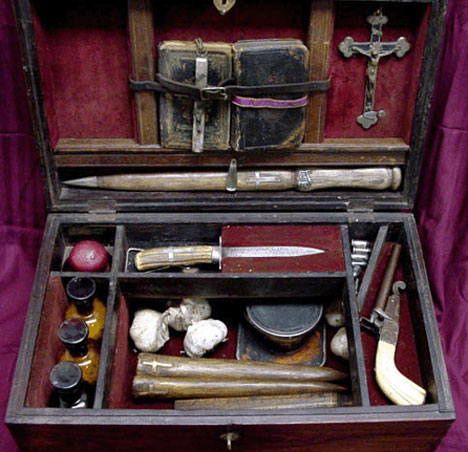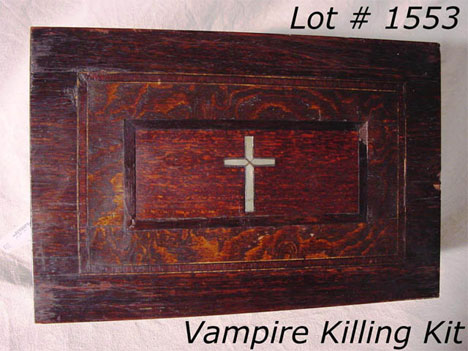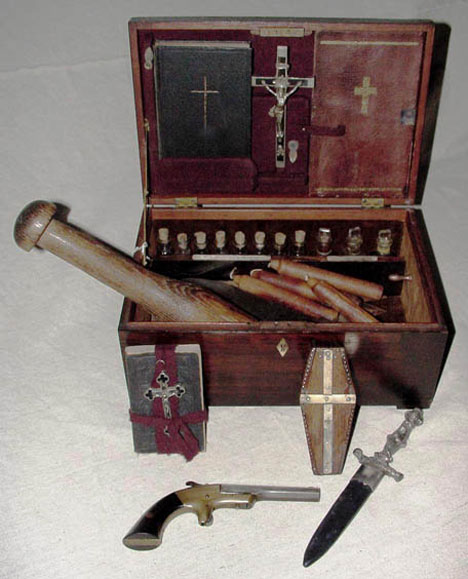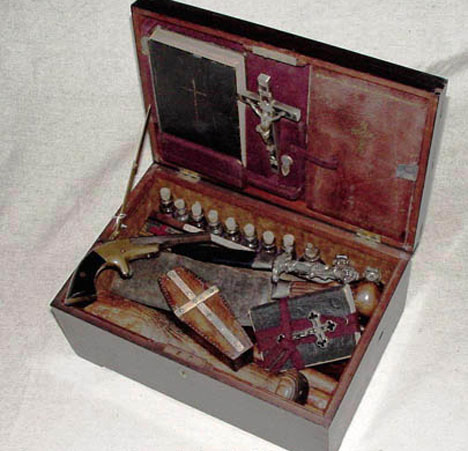Antique Vampire Killing Kit sold at auction for $14,850 in Natchez, Mississippi
Recently we related the story of Australian authorities offering a $1 million reward for the capture of a “Vampire” killer, Vampire Killer Sought by Aussie Authorities: Million Dollar Reward Offered. We posted a photo of an “authentic” vampire killing kit, circa 1800, that fetched $14,850 at an auction held in Natchez, Mississippi.
A sharp-eyed reader wondered how a circa 1800 vampire killing kit existed before Bram Stoker’s Dracula was published in 1897. This observation piqued our interest on the subject of the kits and when they came into existence. We discovered a second killing kit was up for auction held by the same company, Stevens Auction, that sold the “1800″ killing kit, slated for October 31.
Prior to the upcoming auction, Stevens had sold four of the vampire killing kits in the past 27 years.
From Collector’sQuest.com:
Fascinated, I spoke with Dwight Stevens, of Stevens Auction Company, on the phone yesterday about the antique piece of vampire history.“I don’t believe in vampires — I’ve never met one. But somebody believed in them, something drove people to believe… From New Orleans to Vicksburg, these old boxes remain.†Stevens has sold four vampire killing kits in his 27 years as an auctioneer, most recently selling one a year ago, in Natchez, Mississippi, for $14,850.
The statement from Stevens, which seemed to intimate that the denizens of the deep South “believed” in vampires and thus procured vampire killings kits, fascinated me, but then again, the superstitions and the world of voodoo in the gothic setting of moss-draped oaks and the hot and heavily perfumed air of the deep South seems to be the perfect setting for vampires. A Setting which writers such as Anne Rice, a native of New Orleans and the fabulously successful author of the fictional The Vampire Chronicles whose 1976′s “Interview with a Vampire”-details the character Luis who encounters the vampire Lestat in 1791′s Louisiana. And, Charlaine Harris, native of Tunica, Mississippi, and author of The Southern Vampire Series, set in modern day Louisiana in the fictional town of Bon Temps, where vampires attempt to coexist with humans. The HBO series, True Blood, is based on Harris’ books.
The following images are of the latest vampire killing kit slated to be sold in an estate auction to be held on October 31 in Port Gibson, Mississippi, at the home of the late Miss Isabel Person.
Stevens included a short bio on Miss Person, 93, and her home written by her nephew. The Rosewood boxed killing kit contains items such as a silver bullets, pistol, Holy Water, prayer book, vials, and a silver dagger. There’s no info as to why or how the killing kit came into Miss Person’s possession, or, the age of the kit.



Stevens didn’t include the “date” of the kit. Even so, upon further research into vampire killing kits, we discovered several controversies surrounding the origination of the kits. One such kit was auctioned off by Sothebys in 2003 for $12,000.
From USA Today:
According to Sotheby’s, some experts believe that such kits were commonly available to travelers in Eastern Europe in the 18th and 19th centuries, while others think the kits were made in the early 20th century, possibly to cash in on interest in vampires sparked by the 1897 publication of Bram Stoker’s Dracula.Elaine Whitmire, head of 19th century furniture for Sotheby’s, said she believes the kit was assembled in the early 20th century and sold to travelers as a souvenir.“My opinion is this is a memento that you bought while you were in Europe,” she said. “I doubt it was cheap to buy.”
The Professor Blomberg Vampire Killing Kit
Added to the mix, the admission by one Michael De Winter in 2005 that he was the “originator” of the “antique” Professor Blomberg vampire killing kits.
From LesVampires.org:
I am prompted to write this true story of The Vampire Killing Kits, which have proliferated during the last few years since the coming of the Internet.
My story starts in or around 1970 when I was employed in the printing industry. My hobby was buying, selling and refurbishing antique guns. I sold mainly at the famous Portobello Market in London. My usual stock of guns for sale was only 10-20 at any one time and these tended to be of superior quality. I had a number of regular clients who arrived every week to see if I had any new stock. One of my regulars wanted a fine flintlock pistol and asked me to take in part exchange a Belgian percussion pocket pistol. I grudgingly agreed and allowed him 15.00 off the price of the flintlock.
In the LesVampires link, De Winters details how he put together the kits. The site, Spookylandcryptshas more on the Bloomberg Killing Kits but also states there are other “kits”, including examples which exist at the Ripley Museums.
The question that still remained was whether such “killing kits” would have been in existence in Europe prior to the publication of Irish author Bram Stoker’s Dracula in 1897. According to Wikipedia, Stoker didn’t “invent” vampires but that Stoker’s novel and his character Dracula, were “singularly” responsible for the popularity of “modern day” vampires in films and television.
According to Beverley Richardson, vampire myths go back a thousand years and occur in “every culture” in different forms and varieties. The type of “vampire” portrayed today in film and book fiction are largely based on Eastern European myths which originated in China, Tibet, and India, myths which traversed the silk route to the Mediterranean. The wearing of capes, drinking blood, preying on humans at night, ect., are more “modern” versions of vampires based on Eastern European myths and lore.
According to Vampires in Myth and History, the word vampire was added to the English language in 1732 based upon a German translation that stemmed from a case that occurred in Serbia. Western scholars “seriously” considered the “existence” of vampires after two “well-documented” famous cases occurred in East Prussia in 1721 and the Austro-Hungarian Empire from 1725-1734.
Both incidents were investigated, well-documented, and written about in books which, at the time, circulated in Europe. One such case involved Arnold Paole, a Serbian, believed to have become a vampire after his death in 1725. Prior to his death-Paole purportedly broke his neck after falling off a hay wagon-Paole told people that he had been “plagued” by a vampire but that he had “cured” himself by “eating the soil” from the vampire’s grave and “smearing himself with his blood”. Allegedly, after Paole’s death, four people who complained they were being “plagued” by Paole died “shortly after”. Ten days later, with the permission of the local authorities, Paole’s body was exhumed from his grave where “fresh blood” allegedly flowed from his eyes, mouth, nose, and ears. That his shirt, the coffin covering, and the coffin were “bloody”. “Concluding” Paole was a vampire, a wooden stake was driven through his heart.
For a more complete detailing of vampire myths read Vampires in Myth and History.
As for whether residents of the Deep South procured vampire killing kits in order to protect themselves from local “vampires”, there seems to a lack of written documentation as to the existence of “cases” which have been linked to vampires. As to whether the vampire killing kits are “authentic’, Sothebys believed the vampire killing kit auctioned off for $12,000 was made in the early 20th century as a souvenir while Michael De Winter stated he was the creative genius behind the “Professor Blomberg vampire killing kits” which were then sold as “authentic” vampire killing kits made in the 1800′s. Historically, vampires were part and parcel of European forklore with two well-known documented cases in the 1700′s. Cases which were later written about in books which circulated in Europe prior to Bram Stoker’s fictional account of Dracula published in 1897. As to whether there were vampire killing kits in existence prior to Dracula’s emergence in popular fiction, the only “evidence” are the “kits’ that occasionally pop up in auctions, on Ebay, and the few that are kept in museums such as Ripleys.
From the article- Vampire Killing Kits: Fake....Oct 26, 2009 By LBG-
Related articles
- Incredible Vampire Hunting Kit From The 1800's (tinaculit.wordpress.com)
- 1800's Vampire Hunting Kit (neatorama.com)
- Supernatural Defense Equipment - The 1800's Vampire Hunting Kit Shows Blood-Suckers Who's Boss (TrendHunter.com) (trendhunter.com)
- Authentic Vampire Slaying Kit (retrorambling.wordpress.com)
- The Vampire Diaries Vs True Blood (Poll) (houseofvampires.wordpress.com)
- Teen Vampire Arrested For Breaking, Entering and Feeding [Crime] (gawker.com)
- Police seize fake IDs and passports in Pickering (theglobeandmail.com)
- Vampire Bats Attack! (weeklyworldnews.com)
- Nigeria Extradites Man Accused of Scamming Law Firms Out of $31M via Check Fraud Scam @ABAjournal (8/15/11) (vinhsulaw.wordpress.com)
- "True Blood" recap 4x8: Vampire trust issues (salon.com)
- True Blood trips balls on a V-juice hump-hump-fest [Video] (io9.com)
- "True Blood" recap 4x8: Vampire trust issues (salon.com)
- Teen claiming to be vampire jailed after biting woman's neck (obscurestore.typepad.com)
- Favorite Vampire of All Time (Poll) (houseofvampires.wordpress.com)
- On the Market: Former New Orleans Home of Vampire Enthusiast Anne Rice (casasugar.com)
Labels:
Anne Rice,
Arts,
Bram Stoker's Dracula (Collector's Edition),
Interview with the Vampire,
Mississippi,
Natchez Mississippi,
The Vampire Lestat,
Vampire
DEATH DEALER'S AND THIER TRAVEL SIZE WOODEN BOXES OF PAIN AND VENGENCE.
The Old Fashioned Vampire Killing Kit with Garlic Syringe -- This one sold on Ebay. Supposedly dates to circa 1880 Romania. Contains knife, syringe (for garlic solution), metal teeth pliers (for removing fangs), miscellaneous crosses, and bottles of holy soil. Is it just me, or does that mallet look kind of small?
The London Great Exhibition Vampire Hunting Kit -- This one sold at Sotheby's for $12,000. It was supposedly originally offered for sale at the Great Exhibition in London in 1851. Oh, those wacky Victorians
The Cross Gun & MYOB (Make Your Own Bullets) Vampire Kit -- Also sold at Sotheby's. Part of a set of two made by the dubious "Nicolas Plomdeur" who is supposedly a master gunmaker. Larger one comes with a "make your own bullet" mold. That cross is actually a gun. Comes with small powder keg and mahogany stake. Fancy!
The Professor Ernst Blomberg Vampire Hunting Kit -- There are many kits floating around made by 19th century quack Professor Ernst Blomberg.
The Luxury Vampire Hunting Kit, Retro-Style -- This one, called French Vampire Hunting Kit, No.3,
Unknown Source
Long before vampires were the sparkling love interests of every tween girl, they were feared by everyone from innocent children to wise old priests. The intelligent thing to do, as everyone knew, was to kill them on sight. These antique 19th century vampire killing kits have caused quite a stir in the last couple of years among auction-goers, with the one above selling for a shocking $14,850 in 2008
Over nearly 30 years of auctioneering, Stevens Auction Company of Mississippi has seen four of these high-quality kits pass through their possession. They sold this kit in 2009 for $8000, a pretty reasonable price considering the age and quality of the item.
The outer box is solid rosewood, and it contains just about everything you need to slay the undead: a Bible and prayer book, a mirror, vials of holy water, a silver dagger, some candles, a crucifix, wooden stakes, a cleaver and a tiny pistol with silver bullets
These kits were apparently not made as jokes: they are solid, high-quality tools that would have been quite expensive when new. What would the original owner of this kit think if he or she could see the way tweens fawn over vampires these days? Those tweens would no doubt be the subject of some suspicion for sympathizing with such evil supernatural beings.
Related articles
- Alex Van Helsing: Voice of the Undead by Jason Henderson (collectedmiscellany.com)
 Image via Wikipedia"It was 1954 when a worn wooden box was mysteriously donated to the museum. The box came with a letter in which the anonymous donator explained that he had inherited the box from his father who had died unexpectedly a few years earlier after a short period of disease."
Image via Wikipedia"It was 1954 when a worn wooden box was mysteriously donated to the museum. The box came with a letter in which the anonymous donator explained that he had inherited the box from his father who had died unexpectedly a few years earlier after a short period of disease." 
When we inspected the box it seemed to contain various devices of the sort that could be used hunting and destroying vampires. Alongside these remarkable contraptions lay detailed writings that upon further scrutiny were found to consist of a major life long study encompassing the shadowy world of vampires and vampirism.
All items and notes that could possibly reveal the donator, or his late father’s, identity had been carefully removed, but what we have been able to ascertain after studying the various contents of the box is that the previous owner was active as a vampire hunter from the end of the 19th century up until the middle of the 1940s. We also know that he had comprehensive medical training and that he was active in Western Europe, Russia, and on at least one occasion in the Middle East.
With these rare items in our possession and with the increased knowledge they have brought with them, we are now in a position to present the modern public with the astonishing story of a Swedishmedical doctor’s long forgotten struggle against the undead during the first decades of the last century
FROM the website -http://www.cagliostro.se


Related articles
- Can vampires go in the sunlight (wiki.answers.com)
- 'Supernatural' Angel Heads to 'The Vampire Diaries' (buddytv.com)
- Vampire Folktales I'd Love to See on Film - Vampires.com (houseofvampires.wordpress.com)
- How do you be a beautiful vampire in elder scrolls 4 (wiki.answers.com)
Labels:
Dracula,
Eric Northman,
Horror,
Middle East,
Otherkin,
People,
Russia,
Vampire,
Vampire Diaries,
Western Europe
 Image via Wikipedia
Image via Wikipedia
Original title 'Al Azif' - azif being the word used by the Arabs to designate that nocturnal sound (made by insects) suppos'd to be the howling of daemons.
For his novels, the American writer H P Lovecraft, created the fictional book The Necronomicon. In Lovecraft´s gothic world of horror The Necronomicon is a book containing appalling truths about the concealed history of the world and dark rituals with the power to destroy all life on earth. Ever since Lovecraft through his novels aroused interest in The Necronomicon both inquisitive readers and students of the occult have discussed the possibilities of The Necronomicon´s real life existence. What is the dark truth hidden behind H P Lovecraft´s fictional grimoire?
Over the years many theories have been presented and many fake copies of the book have appeared. But the best clues to the true history behind the mythical Necronomicon we find in Lovecraft´s own writing. Lovecraft is careful to say that his Necronomicon is a work of fiction, but in his own biography of Necronomicon (History of the Necronomicon. 1927) he makes many deliberate mistakes that give us clues to the truth behind Lovecraft's fiction. A truth that Lovecraft himself probably was well aware of, but didn’t consider appropriate to reveal through his short stories and novels.
Lovecraft tells us that his Necronomicon is written during the 700's AD by the mad Arab, Abdul Al Hazred, in Damascus. But who was the real author of this remarkable book? The astrologer and writer, Abu 'Ali al-Hasan, has been indicated by many. Also the Jewish mystic Alhazen ben Joseph has been proposed. Most, however, suggests that Lovecraft's mad Arab Abdul Al-Hazred´s real name was Abu al-Husayn, known as Ibn al-Rawandi or Rhazes.
 The Necronomicon
The NecronomiconRhazes was born in 827 A.D in Marwarrudh, present-day northern Afghanistan. Early in his life he joined the Islam-critical Mutazila of Baghdad, and gained prominence among them. He also studied Kabbalah, Sufism, Arabic and Christian Gnosticism. He writes several books in both theology and philosophy, the most famous of these being the Kitab al-Zumurrud (The blinding emerald), of which only fragments remain.
After his years of occult studies Rhazes began to undertake pilgrimages and expeditions to remote and wild places. He spends several months with an unknown master deep in the ad-Dahna desert before he disappears for more than 10 years without a trace in the Rub 'al Khali´s red desert. According to his own writing, he lives during this time in the lost mythical city of Iram, where he is studying ancient and secret teachings.
When he finally leaves Iram and the Rub 'al Khali desert, he travels to Alexandria and Cairo and then to the necropolis of Saqqarah in Memphis. Rhazes devoted the rest of his life to the study of the occult and to the writing of his book, Al Azif. According to the medieval historian Ibn Khallikan, the aged Rhazes probably dies in Damascus in the year 911 A.D, while the German history scholar and theologian Josef van Ess place Rhaze´s death in Alexandria in 919 A.D. Both refer to the Jewish writer and mystic Ephraim ibn al-Za'faran, who without mentioning any details, claims that the aged Rhazes died a very violent death.
 Grigorij Jefimovitj Rasputin
Grigorij Jefimovitj RasputinThe Al Azif is spread in only a few copies among Arab mystics and theologians. The book is banned as soon as the contents become known and all known copies are destroyed. During the early 1100'sAl Azif is translated into Greek, probably in The Monastery of Saint Paul the Anchorite in Egypt, and given the title Νεκρονομικòν (Necronomicon). In 1211 the Greek translation is banned, and all known copies burned by the Constantinople Patriarch Michael IV Autoreianos.
In the early 14th century the Al Azif is for the first time translated into latin by Arnaldus Villa Nova (1235-1311), probably based on a now lost Arabic original. In 1389 Pope Boniface IX bans both Arnaldus the Villas Latin translation and the earlier Greek. Boniface orders all the copies he could find to be burned.
Some sources claim that one of the Greek translations of the Necronomicon comes to Russia at the fall of Constantinople in 1453. The book was allegedly kept in the in the Czar's private library until the fall of the Tsarist empire. There are rumours about additional copies that were printed during the 1500s. Rasputin claimed to own one of these books, which supposedly was a gift from Tsar Nicholas´s third wife. None of these copies are known today.
The only known copy of the original Arabic Al Azif text, and the banned Greek translation, was destroyed or stolen when Bedouins looted the Monastery of Saint Paul the Anchorite and burned its library in the year 1448 A.D.
In 1541 the German alchemist and mystic Theophrastus Paracelsus prints his own German translation of Arnaldus the Villa Nova's version. A copy of Paracelsus's book is said to have been taken as booty by the Swedes in Prague in 1648 but was probably destroyed in the great fire at the Royal Palace in Stockholm in 1697.
During the early 1600s the English mystic Dr John Dee completes his translation of the Villas Latin Necronomicon into English. The text is not published until after Dr. Dee's death. Meric Casaubon prints Dee’s English translation in a very small edition in 1651.
In 1652 the Danish physician Olaus Wormius is having Arnaldus the Villa Nova's Latin translation printed in Germany.

The Necronomicon, in all its versions, are considered by experts to be one of humanity's most dangerous books. The horrific insights and dark truths that this book, in a frighteningly convincing way, gives its readers, has often led to insanity and death. In addition to the ancient truths and foreboding prophecies, the book also contains spells and incantations, which in the wrong hands can do unthinkable damage. All known copies of The Necronomicon are therefore kept under lock and key and are not available to the public. Several organizations and society’s are for different reasons searching for any copies of the book that is still in private hands. Any attempt to spread the Necronomicon´s content has failed due to accidents which are either blamed on the curse that seem to accompany the book, or on any of the conspiracies that surrounds everything concerning The Necronomicon.
Our copy of Dr. John Dee's English translation of the Necronomicon, in Meric Casaubons 1651 edition, are included in the original inventory lists and we do not know how it originally ended up in our collections.
The book and its contents are not accessible to the public. We exhibit only those pages from the book that authorities in the area considerers harmless.
Related articles
- Necronomicon (miskatonicbooks.wordpress.com)
- Spotted Online - A Lovecraft Retrospective (battlegrip.com)
- Wisconsin Novelist Releases Lovecraft Tribute Soaked in Badger Red (prweb.com)
Labels:
Art,
Cthulhu Mythos,
Fiction,
H. P. Lovecraft,
Horror,
Literature,
Necronomicon,
Online Writing,
S. T. Joshi,
The Dunwich Horror






































